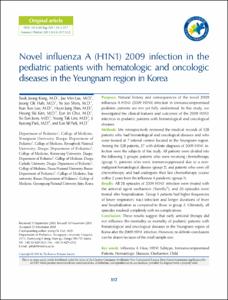Novel influenza A (H1N1) 2009 infection in the pediatric patients with hematologic and oncologic diseases in the Yeungnam region in Korea
- Keimyung Author(s)
- Kim, Heung Sik
- Department
- Dept. of Pediatrics (소아청소년학)
- Journal Title
- Korean Journal of Pediatrics
- Issued Date
- 2011
- Volume
- 54
- Issue
- 3
- Keyword
- Influenza A Virus; H1N1 Subtype; Immunocompromised Patients; Hematologic Diseases; Oseltamivir; Child
- Abstract
- Purpose: Natural history and consequences of the novel 2009 influenza A H1N1 (2009 H1N1) infection in immunocompromised pediatric patients are not yet fully understood. In this study, we investigated the clinical features and outcomes of the 2009 H1N1 infection in pediatric patients with hematological and oncological diseases. Methods: We retrospectively reviewed the medical records of 528 patients who had hematological and oncological diseases and who were treated at 7 referral centers located in the Yeungnam region. Among the 528 patients, 27 with definite diagnosis of 2009 H1N1 infection were the subjects of this study. All patients were divided into the following 3 groups: patients who were receiving chemotherapy (group 1), patients who were immunosuppressed due to a nonmalignant hematological disease (group 2), and patients who were off chemotherapy and had undergone their last chemotherapy course within 2 years from the influenza A pandemic (group 3). Results: All 28 episodes of 2009 H1N1 infection were treated with the antiviral agent oseltamivir (Tamiflu®), and 20 episodes were treated after hospitalization. Group 1 patients had higher frequencies of lower respiratory tract infection and longer durations of fever and hospitalization as compared to those in group 2. Ultimately, all episodes resolved completely with no complications. Conclusion: These results suggest that early antiviral therapy did not influence the morbidity or mortality of pediatric patients with hematological and oncological diseases in the Yeungnam region of Korea after the 2009 H1N1 infection. However, no definite conclusions can be drawn because of the small sample size.
- Keimyung Author(s)(Kor)
- 김흥식
- Publisher
- School of Medicine
- Citation
- Seok Jeong Kang et al. (2011). Novel influenza A (H1N1) 2009 infection in the pediatric patients with hematologic and oncologic diseases in the Yeungnam region in Korea. Korean Journal of Pediatrics, 54(3), 117–122. doi: 10.3345/kjp.2011.54.3.117
- Type
- Article
- ISSN
- 1738-1061
- Appears in Collections:
- 1. School of Medicine (의과대학) > Dept. of Pediatrics (소아청소년학)
- 파일 목록
-
-
Download
 oak-aaa-03513.pdf
기타 데이터 / 574.78 kB / Adobe PDF
oak-aaa-03513.pdf
기타 데이터 / 574.78 kB / Adobe PDF
-
Items in Repository are protected by copyright, with all rights reserved, unless otherwise indicated.